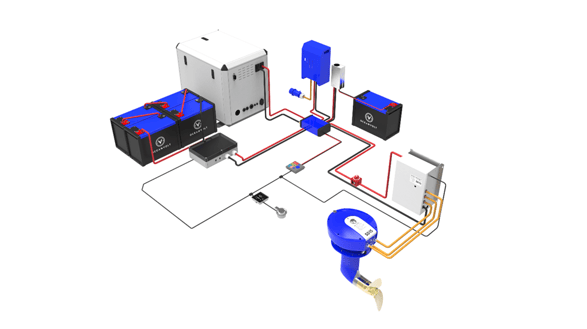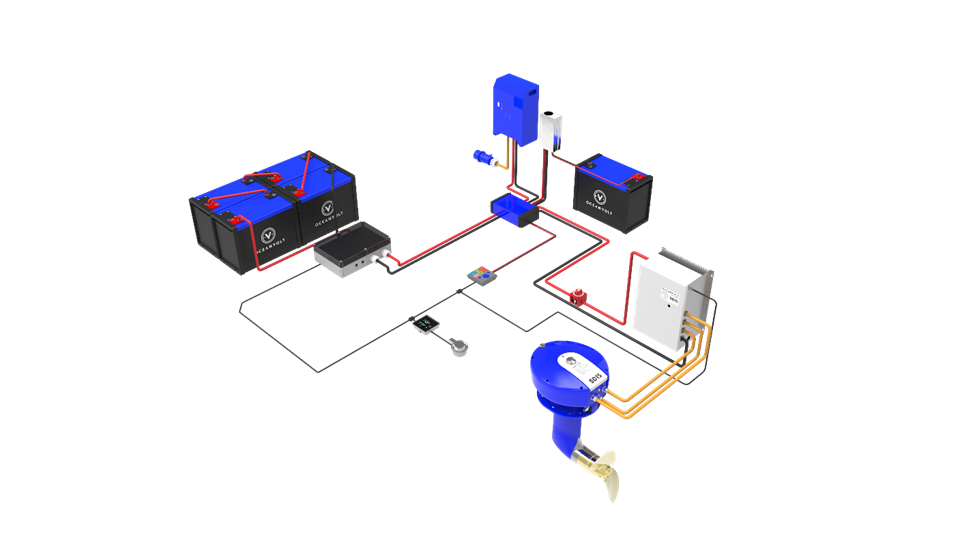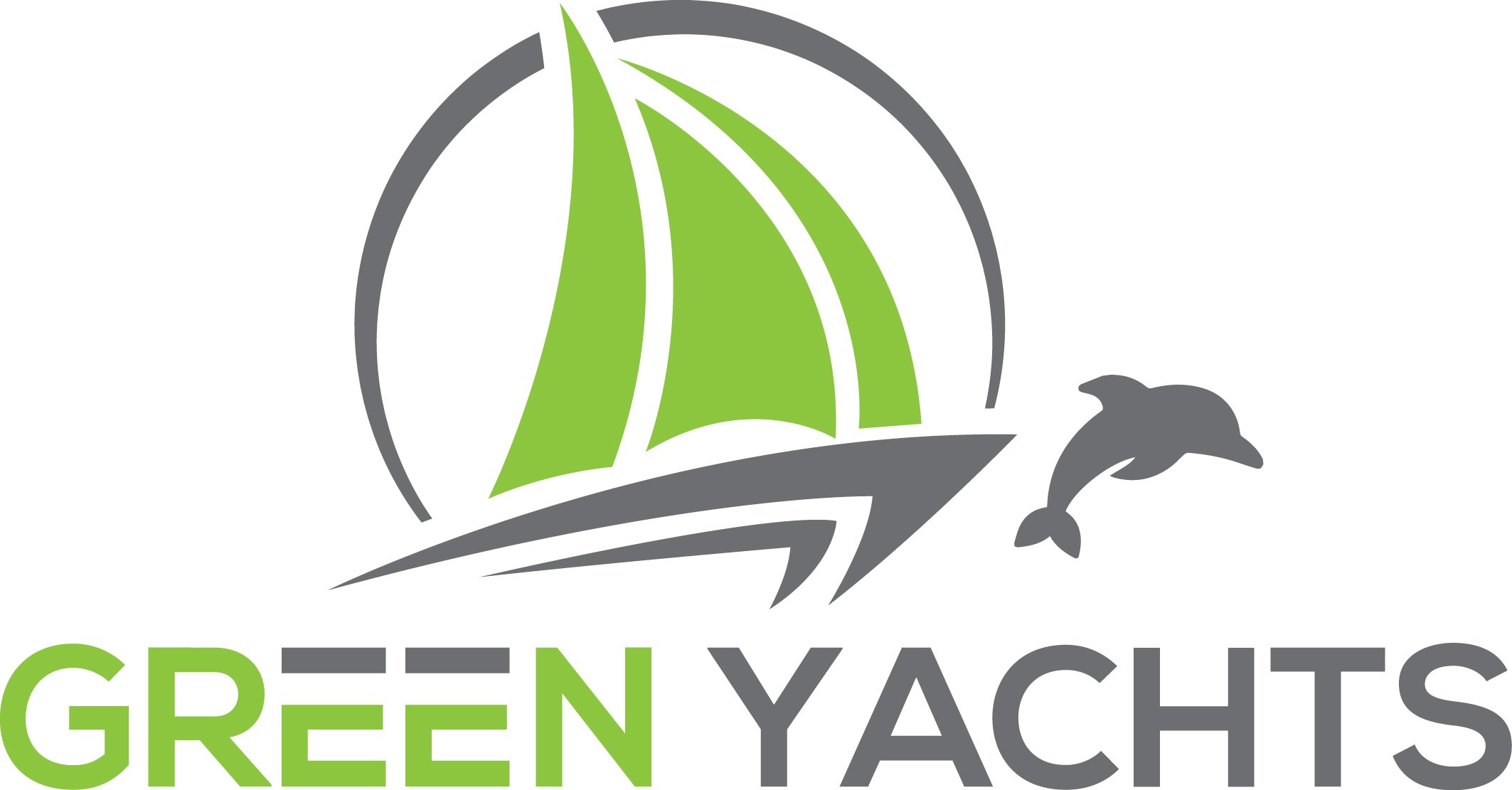There is a lot of variation of what is called a hybrid propulsion system in the marine industry. This blog
looks at the different system that various folks call a hybrid. And, we’ll share our opinion on Green
Yachts on what the definition of hybrid SHOULD be in the marine industry.
1. ICE (Internal Combustion Engine) - To be comprehensive, we’ll start with the ICE, internal
combustion engine, usually a diesel engine, it’s what most recreational boaters and commercial
vessel operators are familiar with. We will refer to the ICE a fair bit in this blog.
2. Integrel - The first ‘hybrid’ in the marine industry is not a hybrid at all. But, it plays an important
part in the evolution of thinking about what a hybrid is. In the 1990s, a brilliant and dedicated
Englishman by the name of Nigel Calder began tinkering with the diesel engine. He came up with
a system, the Integrel System, that was essentially a giant alternator that didn’t put out 800
watts, it put out 9,000 watts that charged a battery bank and improved the efficiency of a diesel
engine by 25%. Though it never gained mainstream acceptance, Nigel is a dedicated sailor with
tens of thousands of miles of experience. Admittedly, for decades he has argued against electric
propulsion as he feels the Integrel system is a better use of energy and that energy storage just
doesn’t meet the needs of a boater. Still, he has a place in the evolution of alternative
propulsion systems in the marine industry Read more...


3. Parallel Hybrid - The next ‘hybrid’ system we look at is the parallel hybrid system. It is defined by having an ICE and an electric motor both being capable of turning the shaft. There are multiple ways that this is accomplished as you can have a pancake motor integrated into the engine as Caterpillar and Mann have done and is pictured below. One can also have a separate ICE and electric motor in-line on the shaft or use a PTI/PTO (power transfer in/out) coupler connecting the ICE and an electric motor to the shaft. The bottom line is that both an ICE and an electric motor (or some other form of zero-emission technology) are capable of turning the shaft and propelling the boat forward. In most cases, the engine is the dominant component with a significantly larger torque rating compared to the motor. It is used in a similar strategy to Nigel Calder’s Integrel system to improve efficiency from 10-25% by using the electric motor at less than ~3 knots and the engine above ~3 knots. commercial vessel beyond 10 miles

There are advantages and disadvantages to a parallel hybrid system. The advantage is that it is more like the diesel engine
4. Serial Hybrid – Unlike a parallel hybrid, an ICE does not have a physical link to the shaft and propeller. Only a zero-emission system is coupled to the shaft and moves the boat forward. In other words, the propulsion system itself is 100% zero-emission and the propulsion system receives electricity from an energy storage system, such as a battery bank. What makes it a hybrid is that an ICE (usually a diesel generator) produces electricity that charges the battery bank. A diesel generator can extend the range of a sailboat beyond 50 nautical miles, a powerboat beyond 20 miles or a

5, 100% Zero-Emission – It is the same set up as the serial hybrid, but without the diesel generator to augment the range. Look at the pictures of the serial hybrid and the zero-emission systems and you will see the modular unit of the DC generator is the only difference. The system can have renewable energy sources augmenting the range such as solar power, hydroregeneration and a hydrogen fuel cell.

Green Yachts advocates that recreational boaters and commercial vessel operators choose serial hybrid or 100% zero-emissions depending on their range needs because both serial hybrid and zero-emission are 100% zero-emission propulsion systems. The difference is the serial hybrid has an additional module added to the system that uses an ICE to guarantee that the zero-emissions system will meet an operator’s range needs without excess battery cost or weight.
A serial hybrid platform can have its ICE component easily replaced with new technology as renewable energy technology evolves that provides sufficient energy for a marine vessel to operate. One only has to remove and replace that ICE module without any change to the rest of the system. In contrast, to convert a parallel hybrid system to zero-emission, the entire propulsion system needs to be replaced. In fact, we know of four parallel hybrid passenger ferries in California that may have a more expensive conversion to zero-emission than other ferries that have an ICE. Furthermore, parallel hybrid is used as a rationale by ICE manufacturers to stay relevant and maintain sales of their engines. Serial hybrid systems are part of the transition to zero-emission transportation, parallel hybrid systems are not. Serial hybrid has more emission reduction potential than parallel hybrid systems. And, serial hybrid systems have more efficient zero-emission operation because the machinery of an ICE system does not create inefficiency for the zero-emission system operation.
This is why we say hybrid is a category lumping two dissimilar strategies together that should not be grouped together. The pretenders who are looking to show they are green have an ICE coupled to the shaft. Those who are investing in a future-proofed system choose serial hybrid or zero-emission. The future is electric as we say at Green Yachts and what we consider hybrid propulsion systems have nothing but an electric motor moving the boat forward with power generation provided by an ICE when needed. That power generation can be sized to augment range or to fully extend range to the equivalent of a diesel powered vessel, but because the ICE is not coupled to the shaft, the system can have components switched out easily as technology evolves without having to change the safety equipment, drivetrain equipment, cooling/ventilation equipment or vessel structure. A zero-emission propulsion system is a future-proof investment in our transition to renewable energy. To learn more, contact Green Yachts.



Leave Comment